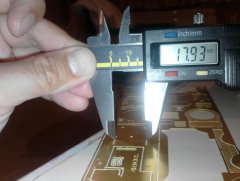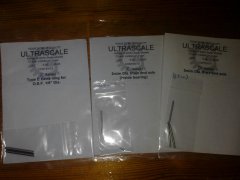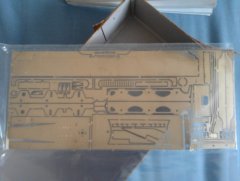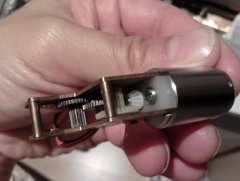-
Posts
1,545 -
Joined
-
Last visited
-
Days Won
4
Content Type
Profiles
Forums
Resource Library
Events
Gallery
Blogs
Store
Community Map
Everything posted by Horsetan
-
Chassis spacers will need to be close to this measurement, for 21mm gauge
Horsetan posted a gallery image in Member Albums
-
Here's a closer look at some of the nameplates that are provided as part of the etch: One of the things that marks the age of the kit design is the absence of a copy of the etches showing the individual part numbers. It must be frustrating to read the instructions and not instantly recognise the parts. I spent the greater part of the evening photocopying the etches onto a sheet of A4, and have been marking off as many of the part numbers on it as I could manage. The thing is, "Weshty" has probably already done this, but is waiting to see if I'll work my way through, for the craic. The oul devil!!
-
I measured the width between the upper cosmetic frames on the engine footplate with digital calipers. This came out at about 17.9mm, and tells me that the chassis spacers underneath should have a width as close as possible to this. 17 or 17.5mm would be a more practical width. Meanwhile I have also ordered a copy of the County Down Railway Trust's book on the "S"-class engines - apparently these have drawings in them. My order went to Cuan Publications of Newtonards, so let's see if anything turns up.
-
I wonder if this was one of the kits for CDR nos.19/20 that were produced by Anbrico. They were the only kits available at that time for this last pair of CDR railcars, and did not replicate the real thing's articulation between driver's cab and passenger section - they came as one fixed unit. Unbuilt ones have commanded large sums in the past. The Anbrico railcar was relatively short-lived in production, and we had to wait about three decades before Worsley Works brought out its own etched kit for 19/20. For more details on the rubber band / O-ring drive idea, click here
-
Things moved on again today, and I was privileged enough to visit Ultrascale's engineering workshop this afternoon to collect the axles that I had ordered only last week: This is one of the fortunate things about living along the way from them (actually, a few miles south) - they give you the option of coming to collect your order personally when it's ready. These axles are from their standard range: the 1/8" driving axles (on the left) are in fact meant for British engines with outside frames / outside cranks, but can be usefully employed, with maybe a bit of trimming, as axles for 21mm gauge driving wheels. The 2mm dia. bogie axles (middle) are also turned out 26mm long. You can specify this at time of ordering, and it gives you the facility to trim them back if they are a bit long. Much easier to do this than find your axles are too short. The 2mm dia. pinpoint axles (right) are the standard 28mm long, as used in 21mm gauge anyway. Again, Ultrascale give you the option of specifying this when ordering. By using standard Ultrascale products, not requiring anything of new design to be made, this can speed things up considerably. All we need now are the wheels themselves, a back-to-back gauge, and some High Level hornblocks and bearings! THOUGHT: it may not be necessary to buy a back-to-back gauge immediately, as Stephen Johnson's helpful diagram suggests that a maximum back-to-back of 19.92mm can be used for Irish broad gauge......
-
Axles, fresh from Ultrascale, to be used on bogie, driving wheels and tender.
Horsetan posted a gallery image in Member Albums
-
Hairclips! Great for holding things together when soldering, like coupling rod / valve gear layers, or hornblock guides when mounting up in the chassis frames.
-
This somewhat grainy shot shows the etch for 171's tender: Looks fairly straightforward. As designed, it has a rigid rear axle, and is meant to place increased weight on the drawbar and contribute to the adhesion of the engine (traditionally a weak spot in model 4-4-0s). I'd like to modify it slightly so that all axles can float.
-
I'd like to see this fit around the M50
Horsetan replied to Flying Scotsman 4472's topic in Trucks, Vans and cars
That's good. I used to get caught up in the tailbacks when coming back from the West on the N4. On one occasion I gave up sitting in traffic and parked in Liffey Valley until things had died down. -
I'd like to see this fit around the M50
Horsetan replied to Flying Scotsman 4472's topic in Trucks, Vans and cars
Never mind getting it around the M50. Wait 'til it reaches the M50 toll plaza. -
They'd be as substantial as the Zurich trams and - believe me - you don't want to be colliding with those either.
-
Have already read through the "S"-class instructions. Hope "Weshty" might allow me to either add notes or corrections as I go along. First point relates to the spacers that are in the kit - they are specifically for "OO" and would be too narrow for 21mm gauge. Don't know whether there are longer ones available but, in my case, I'll have to make my own from nickel silver strip of the appropriate width. The idea is that the chassis below the footplate should be as close (or identical) to the width of the cosmetic frames above it. It also means that there is then enough room for working inside motion / pistons, if such a kit ever becomes available in future. Does anyone have any photos of Slieve Gullion in a dismantled state, showing the cranks and rods, etc. between the frames? Exactoscale wheels look great but are seriously expensive (click here for list), and the driving wheels in particular have a specialised mounting system for which you are required to buy their tool (an extra £30). At the moment, I can't see any wheels that could be used on an Irish engine but I do know I can't afford Exactoscale prices! They do not list anything specifically for Irish broad gauge, but there'd be no harm in asking them whether they can make a batch of Irish BG wheelsets.
-
Get the 28mm axles from Ultrascale. I did! They're about the cheapest things Ultrascale make - postage to Ireland will probably be more than the axles are worth, but if you get a good stock of them it will be worth it. Have you got your Irish back-to-back gauge already? I have to buy one from the Stores......
-
Trip along Harcourt Street Line (July 2012)
Horsetan replied to Csalem's topic in Photos & Videos of the Prototype
I read that when Harcourt Street Station was initially sold off in 1959, it set a record for the highest amount paid at auction for a Dublin property: £67,500. -
Probably because it didn't involve wheels! The pressure's on now, as I must get the wheels from AGW, and hornblocks/bearings from High Level. The bare chassis would act as a cradle to start building the body. For P4/18.83, there's one fella who's getting them to do drop-in sets for the Kernow Beattie 2-4-0 Well Tank. Apparently the project is going to cost at least a grand, so that might give an idea of the sort of costs involved. Make sure you've got a good number of interested subscribers for the 21mm gauge sets, who will put their money where their mouths are.
-
That was weird. I even uploaded the photos into the Forum's own albums, so they should have shown instantly the moment the link was clicked. UPDATE: Ultrascale are just after telling me the Irish broad gauge axle sets are ready to collect. Only one week after ordering!! Unreal!
-
Hurling. The most dangerous game ever to involve several men with sticks. 'tis a gas.
-
Slightly OT: coreless motors and high-efficiency drivetrains
Horsetan replied to Horsetan's topic in General Chat
I understand that there are decoders and controllers that will cater for them. Coreless motors have two terminals, same as any iron-core motor. I use DC so I have a Pentroller or PICtroller to supply power. -
Reminds me of the early days of LUAS, when some drivers were trying to "beat the tram", and generally coming off second-best.
-
Click here for some close-up views
-
Slightly OT: coreless motors and high-efficiency drivetrains
Horsetan posted a topic in General Chat
As a sort of sub-thread to my GNR(I) "S"-class project, and "Weshty" was after asking anyway, I thought it might be of interest if I posted up some of the motors and gearboxes that I prefer to use. Wherever possible, I like to use coreless motors and reversible drivetrains. Best example of this is the Escap RG4 which came in three sizes: 1219 (the motor was provided by Faulhaber, not Portescap): 1616: and 1624: They were widely available from the late 1970s until about 2005, when difficulties in supplying the gears meant that these combinations disappeared from the market. They now command fairly high prices on eBay. Fortunately I bought most of mine when they were in production and accumulated about 20 of them. The great thing about coreless motors is the very low current consumption needed to get them started, whilst the bevel-and-spur gears don't lock up when the power is "off". You can hand-push a model and its wheels will keep on revolving; you can't do that with worm drives. The motors themselves are still being made and are fairly easy to get hold of. My question is: is there not a gear maker in Ireland who could reproduce the bevel-and-spur geartrains at a reasonable price, so that more people can use them?
.png.c363cdf5c3fb7955cd92a55eb6dbbae0.png)






